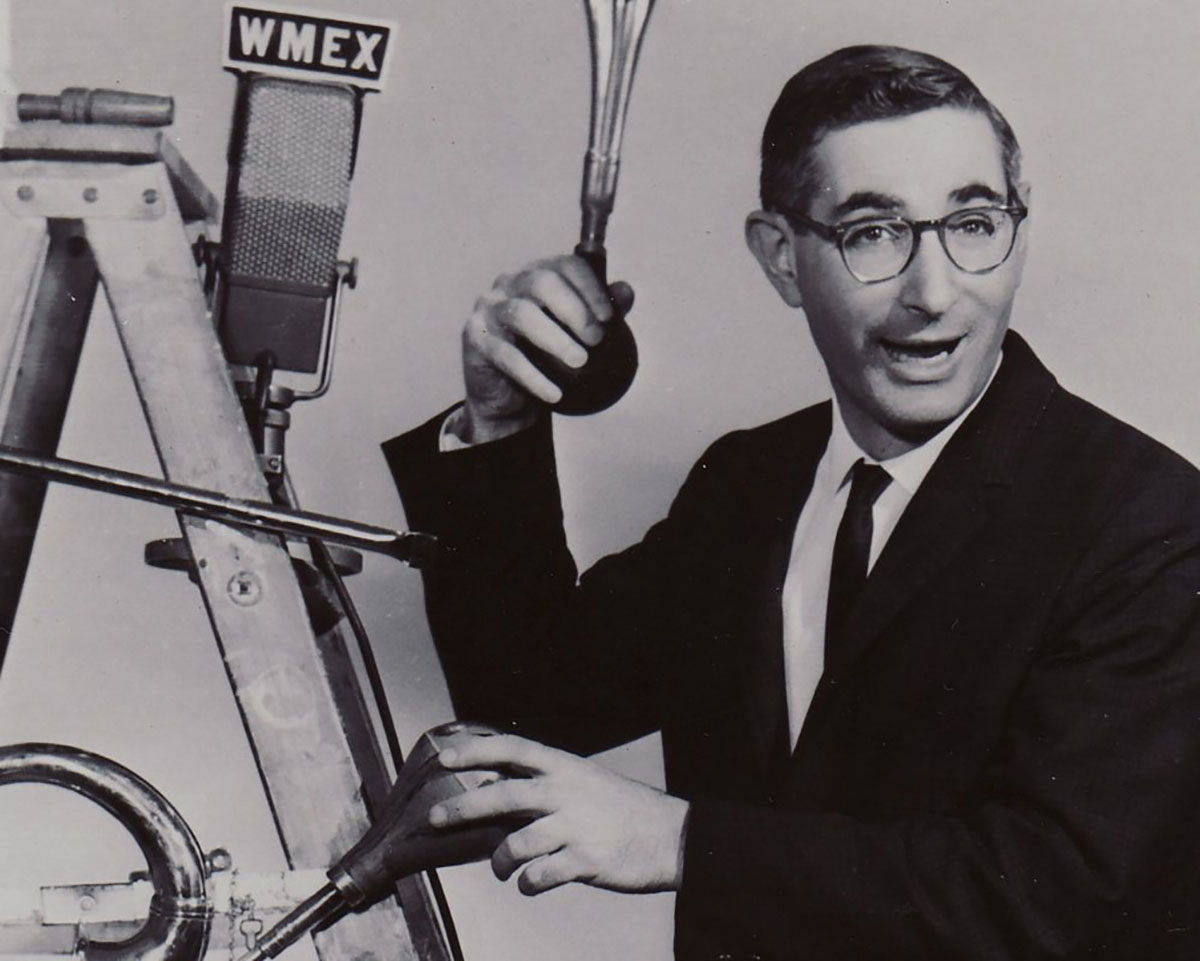New Harvard Exhibit Narrates the Story of Boston Radio
This post originally appeared on Vanyaland.

Arnie “Woo-Woo” Ginsburg / Photo via Radio Contact
The story of radio is one far from completion, but at relative odds with itself. On one hand, the internet has proven that the saga is ever-evolving, with a future that’s promising but completely uncertain, but on the other, there’s a real sense of finality to the era of FM (and even moreso for AM’s long-gone appeal and reach).
Ian Coss, a PhD student at Boston University, radio journalist, and local musician, set out to tell the tale of Boston’s involvement with the growth and success of radio over the past several decades with Radio Contact, an audio oral history of the Boston airwaves with an exhibit that opens tomorrow, March 11, at the Collection of Historic Scientific Instruments at Harvard University (1 Oxford St. in Cambridge). It’s presented as part of a special exhibit on radio technology and culture.
Billed as taking “a broad view—covering everything from music shows and propaganda broadcasts to ham radio transmissions and Internet radio algorithms,” the series includes discussions with ’60s radio icon Arnie Ginsburg, longtime Boston Red Sox radio voice Joe Castiglione, and Spotify developer Paul Lamere of the Echo Nest. Seven of the interviews can be heard below.
Coss, who worked with editor Julie Caine of Bay Area public radio station KALW on the project, says Radio Contact has family roots.
“[It’s a] personal connection, for one,” Coss writes via email. “My grandfather and great-uncle (Paul Coss, one of the oral history stories) were both broadcasters in the city going back to the ’40s. I was familiar with the museum from some previous work, so when I heard about the upcoming radio exhibit I pitched the idea of an audio companion that would provide a more personal and local perspective. This is really just a sample of course; Boston has such a long and rich radio history, but maybe I’ll have a chance to expand on it at some point.”
Listen to a few of the interviews below, with bios provided by Radio Contact.
Paul Horowitz: “We didn’t find anything, so the search goes on.”
Paul Horowitz is a professor emeritus of Physics and Electrical Engineering at Harvard University. He was tuned into radio from an early age thanks to his tech-savvy older brother, and at eight years old Horowitz became the youngest licensed ham radio operator in the world. This interest in long-range communication eventually led him to become involved with SETI: The Search for Extraterrestrial Intelligence. Horowitz describes his fascination with radio and his time spent working at ARICEBO—the largest radio receiver on earth—where in 1978 he conducted a path-breaking search for radio signals from other star systems.
Arnie Ginsburg: “I had a batting average I’d say of 70 or 80 percent.”
Arnie ‘Woo-Woo’ Ginsburg was born just outside Boston in 1926 and became the city’s most popular disc jockey during the 1950s and ’60s. On air he was unlike anyone else—from his name and voice to his creative advertisements and sound effects. Ginsburg spent much of his career at the AM station WMEX; he later worked for WRKO and was a part owner of the FM station Kiss 108. Since retiring Ginsburg has lived in Ogunquit, Maine, where can be seen driving around with his custom license plate: “Woo-Woo.” Ginsburg describes how his popular Night Train Show first came about, how he got his nickname, and how he accidentally launched what he considered to be a “terrible record” to the top of the charts.
Donna Halper: “People don’t have radio dreams anymore.”
Donna Halper has made her presence felt in the radio world as a broadcaster, management consultant, historian, and author. Growing up in Dorchester, she found solace on the radio and idolized the local disc jockey Arnie Ginsburg (also featured on Radio Contact). Years later as a student at Northeastern University she challenged the administration to be allowed on the air. Halper has a PhD in Communications from the University of Massachusetts and now teaches at Lesley University. Her published works include Invisible Stars: A Social History of Women in American Broadcasting, and Boston Radio 1920-1910. She writes at donnahalper.com. Halper is perhaps best known for helping to launch the career of a certain Canadian rock band—she describes the episode in detail, along with her own personal struggles as a woman in broadcasting.
Paul Lamere: “Radio had no skip button.”
Paul Lamere is the Director of Developer Platforms at the Echo Nest, a division of Spotify based in Somerville. He has worked in software development for over 30 years, including at Sun Labs where he headed the Search Inside the Music Project, and holds an M.S. in computer science from Boston University. Lamere writes about music and technology at musicmachinery.com. Much like his predecessors on the radio, Lamere is in the business of programming music for a mass audience. He describes the opportunities and challenges that technology offers in the quest for the perfect playlist.
Joe Castiglione: “It’s our job to make you see it.”
Joe Castiglione was born in Hamden, Connecticut, and raised a Yankees fan—as he puts it: “we all learn from our mistakes.” He attended Colgate College in Maine, where he became the radio voice of the school’s football and baseball teams. In 1979 Castiglione began announcing for the Cleveland Indians, but he came to Boston just four years later. 2016 will mark his 34th year with the Red Sox, during which time he has announced three World Series victories. Castiglione ended the first of those championship seasons with the call “Can you believe it?”—which became a catch phrase of the team and later the title of his second book. He currently lives on the south shore of Boston with his wife and lectures in the Department of Communications at Northeastern University. Castiglione discusses his deep love of the game of baseball, the craft of sports broadcasting, and his own mental preparation for calling the final out of his team’s momentous 2004 championship.
Charles Clemons: “Can you show me how to build one?”
Born and raised in Boston, Charles Clemons has been a serial entrepreneur since he was 12 years old. He began working in radio while still in high school, and at age 19 became the Music Director for WILD FM. He founded TOUCH 106.1 FM in 2006, and since then has become a vocal advocate for low power community radio. In 2009 he even walked from Boston to Washington DC, in support of the Local Community Radio Act. Clemons has also worked as a Boston police officer, managed a limousine service, and run for both mayor and city councilor. In 2014, Touch FM was shut down by the Federal Communications Commission (FCC) for broadcasting without a license. Clemons describes his struggles with the FCC, and articulates the importance of radio representation for communities of color in American cities.
Paul Coss: “We were a propaganda group.”
Paul Coss was born in 1934 and grew up in the “Golden Age” of radio—listening to live serial dramas and music broadcasts from the living room radio set. As a child he worked in the record library at the AM station WHDH, fetching albums for the disc jockeys and even helping to write jokes. Coss’ broadcasting career began in earnest while he was in college at Holy Cross in Worcester; where he started working weekends at a local station. Coss later moved to WCOP in Boston, where he hosted a regular music show eventually became the station’s program director. Over a long career in broadcasting, Coss has moved from radio to television and from coast to coast. He currently lives in Carmel, California. During the late 1950s, Coss was drafted into the army and served as part of the Loudspeaker and Leaflet Company. He recounts his experiences broadcasting in Japan, where he had to walk the line between entertainment and propaganda.


